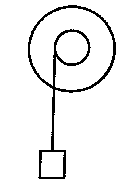![[logo]](images/logo_75.gif)
1996/97 Test 2 Parts B & C
To aid you with your exam preparation, the following are the Parts B and C questions from the 1996/97 second midterm. (NOTE: The Part A questions of the 1996/97 second midterm are the questions in Self-Graded Quiz #2.)B1. A tennis ball of mass 0.0650 kg is initially moving to the left with a speed of 15.0 m/s. After being struck by a tennis racquet, it moves to the right with a speed of 26.0 m/s. If the ball remains in contact with the racquet for 0.0200 s, what is the magnitude of the average force exerted on the ball by the racquet?
B2. A boy is riding a bicycle in a straight line at constant speed. The front wheel of the bicycle has a radius of 0.700 m and is rotating about its axis with an angular velocity of 6.30 rad/s. There is no slipping between the tire and the road surface. Calculate the translational velocity of the bicycle.
| B3. A uniform flag pole of mass 15.0 kg is attached to a vertical wall by a frictionless pivot joint as shown. The pole is held horizontal by means of a vertical cable attached to the end of the pole and the ceiling. Calculate the tension in the cable. | 
|
B4. The acceleration due to gravity at the floor of Death Valley is different from its value at sea level. A pendulum of length 1.00 m is taken to the floor of Death Valley, where its period is 1.95 s. What is the value of g in Death Valley?
B5. A watch is rated 'waterproof' for gauge pressures up to 1.52 × 105 Pa. According to this rating, calculate the depth in water to which the watch can be safely submerged. The density of water is 1000 kg/m3.
C1. A comet fragment of mass 1.96 × 1013 kg is moving at a speed of 6.50 × 104 m/s when it crashes into Callisto, a moon of Jupiter. The cometary debris remains embedded in Callisto's surface. The mass of Callisto is 1.08 × 1023 kg.
(a) Assuming for this calculation that Callisto's initial momentum is zero, what is the speed of Callisto immediately after the collision?
(b) How much kinetic energy was released in the collision?
| C2. A compound pulley is formed from two cylindrical pulleys of different radii, bolted together so that they turn as a unit. The radius of the inner pulley is 0.0500 m and the moment of inertia of the compound pulley is 0.469 kg.m2. An object of mass 2.00 kg is hung from the inner pulley by a massless cord, as shown in the diagram. If the system is released from rest, determine the angular acceleration of the compound pulley. | 
|
C3. A ball of mass 0.500 kg is attached to a vertical spring. It is initially supported so that the spring is neither stretched nor compressed, and is then released from rest. When the ball has fallen through a distance of 0.108 m, its instantaneous speed is 1.30 m/s. Air resistance is negligible.
(a) Using conservation of energy, calculate the spring constant of the spring.
(b) Calculate the oscillation period of the ball-spring system.
Solutions:
View Page 1 (questions B1, B2, B3)
View Page 2 (questions B4, B5)
View Page 3 (question C1)
View Page 4 (question C2)
View Page 5 (question C3)
| Top | Back to Resources Page | HOME |